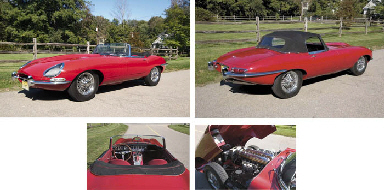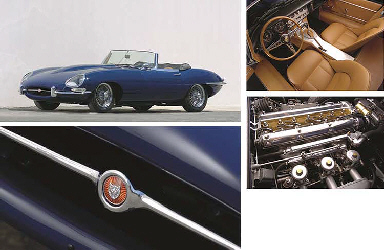1962 Jaguar E-Type 3.8-Litre Lightweight Low-Drag Competition Coupé Coachwork by RS Panels Registration no. 244 YUS Chassis no. 878364 *Full alloy bodywork *New Sigma race engine *Crosthwaite & Gardiner wide-angle cylinder head *A many-time participant in Le Mans Classic, Le Mans Legend, Spa 6-Hours *The most reliable and most successful E-Type in many Jaguar events Fußnoten Right from the moment deliveries commenced in 1961, the E-Type began to find its way on to the world's racetracks. In the Grand Touring class for production sports cars the E-Type proved competitive right from the start, Graham Hill celebrating the model's racing debut by winning at Oulton Park on 3rd April 1961. The elevation of the GT class to Manufacturers' Championship status for 1963 prompted Jaguar to develop a small batch of very special lightweight cars to challenge Ferrari. The FIA's regulations for the Gran Turismo category stipulated that a minimum of 100 cars had to be built, but permitted coachwork modifications, thus enabling Jaguar to claim that its lightweights were standard E-types fitted with altered bodywork. (This is the same loophole exploited by Ferrari to get the limited edition 250 GTO homologated, by claiming that they were re-bodied 250 GTs). In fact, all 12 lightweight E-Types constructed in period were built from scratch with aluminium bodies, though they were invoiced as a new standard road car with additional modifications and numbered in the normal production sequence, albeit with an 'S' chassis number prefix. This was not the first occasion that a low-drag body had been tried on the E-Type; Jaguar's Experimental Department had built one in 1962 but the project was shelved. To create the 1963 lightweight version, the E-Type's steel monocoque tub and outer body panels were remanufactured in aluminium and the engine dry-sumped and fitted with an alloy cylinder black, 'wide-angle' head and Lucas mechanical fuel injection, producing in excess of 300bhp. The production four-speed gearbox was used initially before a ZF five-speed unit was adopted towards the end of 1963. '4 WPD', the works development E-Type racer campaigned by John Coombs and driven by Graham Hill, was converted to lightweight specification and served as the prototype. The 12 cars built by the factory were intended for the use of competition orientated Jaguar dealers or specially selected private entrants. Two of them, campaigned by Peter Lindner (Jaguar's Frankfurt distributor) and Peter Lumsden, were fitted with a revised, low-drag tail section devised by aerodynamicist Malcolm Sayer, the man responsible for the standard production E-Type. This move to a more aerodynamic design had been prompted by the fact that although the GTOs had proved beatable on British short circuits, on faster tracks and in events of longer duration they decisively held the upper hand. The best result obtained at international level by a low-drag E-Type was achieved by Dick Protheroe's ex-works experimental E-Type racer (the solitary prototype of 1962), which triumphed at Reims in the face of stiff GTO opposition, albeit in a race of only 25 laps. Sadly, the lightweight and low-drag E-Types failed to fulfil their potential in the endurance classics, though the car did prove able to take on and beat the Ferrari GTOs at shorter distances. Today, copies of this rare competition variant are among the most popular and sought after of all E-Type replicas. The fabulous E-Type competition car offered here was constructed using an RS Panels aluminium-alloy body patterned on that of the works' experimental one-off low-drag coupé. Shelved by the factory, that car was bought in 1963 by long-time Jaguar exponent Dick Protheroe, and for a while carried his famous registration, 'CUT 7'. The enthusiast vendor advises us that this car has a coefficient of drag 11% lower than the normal E-Type Lightweight. Wind tunnel developed, it has proven to be the most reliable and most successful E-Type in many Jag
1962 Jaguar E-Type 3.8-Litre Lightweight Low-Drag Competition Coupé Coachwork by RS Panels Registration no. 244 YUS Chassis no. 878364 *Full alloy bodywork *New Sigma race engine *Crosthwaite & Gardiner wide-angle cylinder head *A many-time participant in Le Mans Classic, Le Mans Legend, Spa 6-Hours *The most reliable and most successful E-Type in many Jaguar events Fußnoten Right from the moment deliveries commenced in 1961, the E-Type began to find its way on to the world's racetracks. In the Grand Touring class for production sports cars the E-Type proved competitive right from the start, Graham Hill celebrating the model's racing debut by winning at Oulton Park on 3rd April 1961. The elevation of the GT class to Manufacturers' Championship status for 1963 prompted Jaguar to develop a small batch of very special lightweight cars to challenge Ferrari. The FIA's regulations for the Gran Turismo category stipulated that a minimum of 100 cars had to be built, but permitted coachwork modifications, thus enabling Jaguar to claim that its lightweights were standard E-types fitted with altered bodywork. (This is the same loophole exploited by Ferrari to get the limited edition 250 GTO homologated, by claiming that they were re-bodied 250 GTs). In fact, all 12 lightweight E-Types constructed in period were built from scratch with aluminium bodies, though they were invoiced as a new standard road car with additional modifications and numbered in the normal production sequence, albeit with an 'S' chassis number prefix. This was not the first occasion that a low-drag body had been tried on the E-Type; Jaguar's Experimental Department had built one in 1962 but the project was shelved. To create the 1963 lightweight version, the E-Type's steel monocoque tub and outer body panels were remanufactured in aluminium and the engine dry-sumped and fitted with an alloy cylinder black, 'wide-angle' head and Lucas mechanical fuel injection, producing in excess of 300bhp. The production four-speed gearbox was used initially before a ZF five-speed unit was adopted towards the end of 1963. '4 WPD', the works development E-Type racer campaigned by John Coombs and driven by Graham Hill, was converted to lightweight specification and served as the prototype. The 12 cars built by the factory were intended for the use of competition orientated Jaguar dealers or specially selected private entrants. Two of them, campaigned by Peter Lindner (Jaguar's Frankfurt distributor) and Peter Lumsden, were fitted with a revised, low-drag tail section devised by aerodynamicist Malcolm Sayer, the man responsible for the standard production E-Type. This move to a more aerodynamic design had been prompted by the fact that although the GTOs had proved beatable on British short circuits, on faster tracks and in events of longer duration they decisively held the upper hand. The best result obtained at international level by a low-drag E-Type was achieved by Dick Protheroe's ex-works experimental E-Type racer (the solitary prototype of 1962), which triumphed at Reims in the face of stiff GTO opposition, albeit in a race of only 25 laps. Sadly, the lightweight and low-drag E-Types failed to fulfil their potential in the endurance classics, though the car did prove able to take on and beat the Ferrari GTOs at shorter distances. Today, copies of this rare competition variant are among the most popular and sought after of all E-Type replicas. The fabulous E-Type competition car offered here was constructed using an RS Panels aluminium-alloy body patterned on that of the works' experimental one-off low-drag coupé. Shelved by the factory, that car was bought in 1963 by long-time Jaguar exponent Dick Protheroe, and for a while carried his famous registration, 'CUT 7'. The enthusiast vendor advises us that this car has a coefficient of drag 11% lower than the normal E-Type Lightweight. Wind tunnel developed, it has proven to be the most reliable and most successful E-Type in many Jag















Try LotSearch and its premium features for 7 days - without any costs!
Be notified automatically about new items in upcoming auctions.
Create an alert